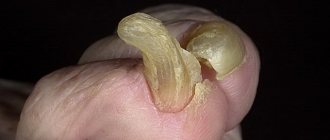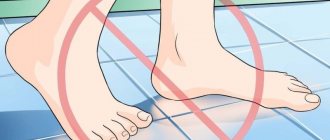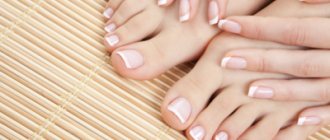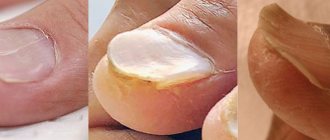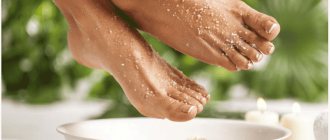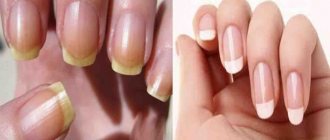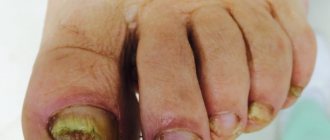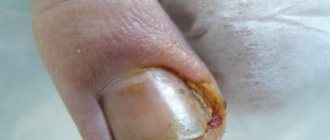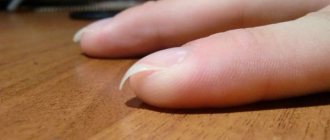Diagnosis of dry nails and finger skin
It is important to carefully examine the nail plate to identify the following signs:
the nail has no shine, is cloudy; there are vertical stripes on the nails; whitish spots all over the nail; lack of smoothness of the nail plate.
These symptoms indicate that the nails lack natural moisture. Nails consist of three layers, the first of which are soft and hard keratin. Between them there is a water-fat composition. If any component is missing, delamination occurs. This problem is more serious. Healing the nail plate becomes more complicated than simply increasing the moisture content between the layers of the nail.
Often, lack of moisture in the body affects the skin around the nails. Redness and peeling appear on it. Sometimes there is severe pain from cracks and wounds. This means that the skin loses its elasticity due to dehydration. The cuticle is also susceptible to moisture loss, resulting in painful hangnails appearing on the fingers. It is wrong to think that only the hands suffer from such troubles. Manifestations of moisture deficiency are also possible on the feet, resulting in the appearance of cracks, wounds, and brittleness of the nail plate. In the case of toenails, the reasons may be more serious.
Causes of dry cuticle
Often, people who do not do manicures face the problem of increased cuticle dryness. Without proper care, the periungual fold dries out and becomes rough, cracks and burrs appear. But even those who regularly visit a specialist or do manicures at home have problems with a lack of moisture in the periungual area.
Causes of dry cuticles and skin around the nail:
- Wrong eating habits. The predominance of fatty and preservative-rich foods in the diet has a detrimental effect on the water balance in the body, including in the cuticle
- Lack of water. Insufficient drinking water reduces the hydration of all body cells.
- Cleaning the house without protective gloves. The composition of household chemicals and cleaning products is rich in substances that not only dry the cuticle; after using an aggressive cleaner, it will become rough and crack instantly. If you constantly neglect protective gloves, deep drying of the periungual area will occur.
- Inappropriate way to perform a manicure. Even if the procedure is performed by a specialist, he may choose a method that is not suitable for a given skin type. The result of such a procedure will be the opposite of what is desired, and the more often it is performed, the drier the cuticle will become.
- Using low-quality nail care products. Nail polish remover, coating, unnatural composition - all this affects the cuticle and leads to its dryness and roughness.
- Exposure to frosty air in winter and salt water in summer. In the presence of such weather factors, increased hydration is mandatory.
Knowing the external causes of dry rollers, it is recommended to take preventive protective measures: use household gloves, protect the skin from frost, rinse off sea water and use products to moisturize the cuticle.
Source of dehydration of nails and skin around them
Before you start using various remedies, you need to determine why the problem occurred. The main causes of nail problems:
use of chemicals in everyday life (washing dishes, hand washing); frequent use of an acetone-containing solution to remove nail polish; daily excess moisture when solving household tasks (dishes, wet cleaning); applying low-quality nail polish; use of an inappropriate file, incorrect filing procedure; deficiency of microelements necessary for the body; diseases of the endocrine system.
If the skin around the fingers and cuticles are also problematic, the following reasons are possible:
improper care of hands and cuticles; using soap with alkaline or antibacterial substances; non-compliance with the principles of healthy eating; presence of fungal infection.
Brittle nails, cuticles with hangnails, or dry skin on the toes may indicate dangerous diseases such as fungus, psoriasis, eczema, reactions to medications, and the development of diabetes.
It is important not to neglect the problem and consult a doctor. If they rule out problems with internal organs, the problem can be solved without their intervention.
Causes and remedies for dry nails
All women want to look beautiful. We carefully select our wardrobe, apply makeup correctly, and do our hair. There seemed to be such a small thing left - a manicure.
But for some reason my nails are not growing well, the color of the nail plate has changed - it has become an unhealthy, gray-yellow shade. Often the plates at the tips peel off, causing the already thin nail to become even thinner and, as a result, break at the slightest physical contact. The skin around the nail plate has become rough and hangnails have appeared. All of the above problems arise when, for one reason or another, your fingernails become dry.
Presence of dry and brittle nails in children
This problem occurs not only in adults. She also often lies in wait for children. A torn cuticle is very painful for a child. The reason for this is considered to be the tenderness of children's skin. Often the precursor to dryness, brittleness of the nail plate, and cracks on a child’s fingers is a fungus that must be treated immediately. The digestive organs should be checked.
A deficiency of zinc, magnesium, calcium, and phosphorus can also affect a child’s nails.
If no obvious diseases are detected, you can reconsider the child’s diet. The baby's diet needs oils, nuts, eggs, dried fruits, fish, buckwheat, and oatmeal. Vitamin deficiency is overcome with the help of specialized vitamin preparations.
Important: Approach the problem comprehensively. Use any vegetable oil (1-2 drops) for daily rubbing and nail bath (2-3 times a week).
To prepare the bath you will need lemon juice (1 tsp), iodine (2 drops), glycerin (100 g). These ingredients should be warmed up a little, and the child’s fingers should be immersed in them for 10 minutes. After the procedure, wash your hands in warm water and wipe with a towel. This action greatly strengthens the child’s brittle nails. It is very important to maintain regularity of procedures.
Self-treatment for dry hands and nails
Dry fingernails require special attention. To heal in natural, home conditions, you can use various products to care for your nails and the skin around them. The nail plate needs vitamins A and E. You can buy them at the pharmacy, add them to any vegetable oil, and then rub them into the nails and the skin around them. Baths and natural masks at home are inexpensive, but the effectiveness of their use is not inferior to expensive salon procedures.
Baths for treating dry hands and feet
Boiled potato bath. Stir 1 cooked crushed potato tuber, 2 cups of water and 1 cup of milk. If desired, you can add olive or burdock oil (1 tsp). Place your hands in the mixture for 20 minutes.
After such a bath, your hands should be rinsed with warm water, wiped with a soft cloth, and lubricated with liquid cream.
The skin on your fingers and palms will stop peeling if you use starch baths. Add 1 tbsp to a liter of water (45–50 degrees). l. potato starch. Soak your hands in the solution for 15 minutes, then wipe them with a soft cloth and lubricate them with a rich (nourishing) cream.
Vitamin bath. For the bath, dilute lemon juice (2 tbsp) and the same amount of sea salt in a glass of water (45–50 degrees), add grape seed oil (2–3 drops). Warm your fingers in this liquid for 15 minutes. After completing the procedure, you should dry your fingers with a towel and apply any nourishing cream. Such baths are recommended to be carried out once a week.
Sea salt and essential oil help increase blood circulation and strengthen the nail plate. It is recommended to include lemon oil, tea tree leaves, burdock, ylang-ylang, and coniferous trees in the composition.
Important: Essential oil must first be diluted in vegetable oil (1-2 drops of essential oil, 1 tsp of any vegetable oil).
Strengthening bath. Dissolve sea salt (2 tbsp) and oil mixture in 1 liter of water (45–50 degrees). Essential oils must be chosen very carefully, taking into account the possibility of an allergic reaction. Fingers should be immersed in the solution for 15 minutes. You can massage your fingers at the same time. You need to do such baths 2-3 times a week. Dry nails no longer bother you. The cuticle from such procedures is also noticeably softened.
Masks to improve the condition of nails and finger skin
Cracks on the fingers can be easily treated with various masks at home. The ingredients can be very diverse.
Nutrition of the nail plate and cuticle occurs simultaneously with the skin of the hands.
A wax mask is carried out in the salon and at home. To begin with, you should heat the pieces of wax by steaming or using a water bath, then cool the wax and stick your fingers into it. Next, take them out and wait until the wax hardens on your fingers. You can wear cotton gloves on your hands. This mask remains on the fingers until the morning, then is washed off with water. The procedure can be performed every two to three days. For a child, such a mask will be fun.
A blue clay mask is carried out in a weekly course. For this, 2 tsp. clays are mixed with 2 tsp. olive oil, 2 drops of iodine tincture. This mixture is rubbed into the nail plate for 15–20 minutes, then washed off with warm water.
For 7–10 days, you can rub oils into your nails, the skin around them, and cuticles daily. This procedure is very useful for both adults and children. You can use olive, avocado, burdock, lemon, and sea buckthorn oils as a basis. Rub the oil into dry nails and cuticles, 2 drops before bed.
In addition to external treatments, dry skin around the nails, nails and cuticles are supported by proper nutrition containing complex carbohydrates and fats. Brittle nails, hangnails, and cracked fingers will no longer bother you if baths and other manipulations at home become regular.
Doctors say that the state of a person’s health can be determined by the condition of the nails. Fragile, brittle, dry nails indicate a lack of vitamins and minerals in the body. The structure of the plate consists of keratin and a water-fat layer. Lack of moisture is manifested by stripes on the nail plate, spots, discoloration and loss of brightness and shine of the nail. Dehydration affects both the cuticle and the skin around the fingers. The main cause of nail problems is considered to be a deficiency of vitamins and minerals. But external influences also play an important role on the condition of the nail plate.
Mistakes in treating toenail fungus
Nail fungus or onychomycosis is an unpleasant disease that may not be noticed immediately. The fungus destroys your nail plate, causing discomfort and pain; if treatment for onychomycosis is started, this can lead to soft tissue pathologies. The fungus can easily spread to healthy fingernails or toenails, and this poses a great danger to your health and the health of others.
If you have any doubts about the health of your nails, the best thing to do is make an appointment with a dermatologist. Only with complex treatment, consisting of a course of medication, regular foot hygiene and special treatment of the nail plates, will the treatment bring a positive result.
Main symptoms of fungal infections:
● Brittle, rough nails
● Deformation of the nail plate
● Presence of inflamed tissue around the nail
● Delamination, thickening or thinning of the nail plate
● Presence of brown, black or yellow areas on the nails.
How do you get nail fungus?
Ways of infection with onychomycosis. If you follow the rules of hygiene, have good immunity, and have healthy and well-groomed skin, the risk of contracting a fungal infection is not high. The fungus often enters the body through abrasions, cuts, cracks, and altered injured areas of the nails and skin. Excessive sweating or dry skin, or wearing tight shoes can contribute to the growth of the fungus.
You are more vulnerable to nail fungus if:
● You have varicose veins
● Reduced immunity
● You wear rubber shoes that don't breathe
● There are endocrine and vascular diseases
● Have been in contact with a person infected with a fungus
● There is flat feet.
What danger does toenail fungus pose to humans?
At an advanced stage of onycochomycosis, nail fungus causes an allergic reaction, has an intoxicating effect on the body, and can affect internal organs.
How to cure nail fungus?
When treating nail fungus, local medications can be used - creams, ointments, patches, which can also be used at home. Various spray options are available that have strong antifungal, anti-inflammatory and antiseptic properties.
At the early stage of the disease, the use of sprays or creams is recommended. Do not forget that treating nail fungus is not only about getting rid of external manifestations. During treatment, the dermatologist prescribes systemic medications. The drug can be prescribed in the form of tablets, which will be taken for a course of three to six months.
The most common mistakes when treating toenail fungus.
The moisture of your feet. Fungus in the form of spores is everywhere around us. When the skin humidity is more than 80%, fungal spores begin to multiply and infect the nail plate and surrounding skin.
The presence of fungal spores on things. When ironing socks with steam, you kill the active fungal spores remaining there. If this is not done, then from the spores, in the presence of damp skin of the feet (favorable environment), high humidity of the shoes, the fungus actively begins to multiply.
Shoe hygiene. When starting treatment for nail fungus, be sure to treat all the shoes you wear. Use a personal towel intended only for feet.
Remains of fungal spores on instruments. All tools for cutting nails must be treated with disinfecting solutions; it is recommended to use disposable files to care for affected nails. If the fungal spores remain on the tools, then you can manually remove them for years, cut out traces of the fungus along with your nail, but this will not bring any results.
What should you follow when treating toenail fungus?
If you do not follow the recommendations during treatment of nail fungus, a relapse may occur. Try to always keep your feet clean and change your socks daily. It is important for your feet to wear the right shoes to prevent your feet from getting sweaty. After taking any water procedures, wipe your feet dry, paying special attention to the area between the toes.
Use an individual foot towel, which must be dried after use. If your shoes become wet, dry them immediately. It is recommended to change indoor shoes at least twice a year during treatment. Foot baths with soda and salt will also be useful. Feet should be washed daily using laundry or tar soap.
Always follow the rules of hygiene when visiting public places: saunas, baths, hammam, swimming pools. Do not self-medicate; it would be best to contact a dermatologist who will prescribe a course of treatment for you so that you can quickly get rid of toenail fungus and save your time and nerves.
Causes
Dry nails
» data-medium-file=»https://i0.wp.com/nogi.guru/wp-content/uploads/2017/01/suhoj-nogot.jpg?fit=200%2C134″ data-large-file= »https://i0.wp.com/nogi.guru/wp-content/uploads/2017/01/suhoj-nogot.jpg?fit=558%2C373″ class=»alignright wp-image-7410 size-medium» src=”https://i0.wp.com/nogi.guru/wp-content/uploads/2017/01/suhoj-nogot.jpg?resize=200%2C134″ alt=”toenails are drying” data-recalc -dims=»1″>The main factors leading to dry nails are: Aggressive dishwashing and apartment cleaning products containing acids and alkalis spoil the top layer of the nail and dry the skin around it. Working with soil. Mechanical pedicure, grinding and treatment with harsh abrasives cause microtrauma to the nail and cuticle. Varnish, acrylic coatings and nail polish removers containing acetone-containing elements dry the top layer of the nail. Metabolic disorders and disruption of the endocrine system have a negative impact on the condition of the nail plate. Nail fungus and skin diseases cause damage to the nail by viruses and microbes.
If the problem is caused by external irritants, then solving it will not be difficult in most cases. It is enough to eliminate exposure to an aggressive environment and carry out the necessary restoration procedures.
Main reasons
Dry nails due to aggressive products
A manicure and beautiful polish are great, but nail polish removers are not always safe: many of them still contain acetone and other chemicals that are extremely harmful to nails and skin. Girls and young women also really like to experiment, and their nails endure these experiments: one polish today, another tomorrow; nail extensions and other ways to decorate them.
Exposure to household chemicals brings even more harm to hands and nails: if we remove nail polish 1-2 times a week, then we do dishes, cleaning and laundry almost every day - not one thing, but another. And we “rinse” in chlorinated water: our nails absorb it, and the plates begin to deteriorate, and calcium and other minerals are washed out - hence dry nails, brittleness and brittleness.
Cheap or too aggressive nail files - for example, metal ones - can cause nails not only dryness, but also serious harm; In addition, women often process their nails in a hurry - they always don’t have enough time for themselves - and move the file “haphazardly”, trying to quickly get the desired shape. Such manipulations easily damage the nail structure; then household chemicals get into their fabric and - “the process has begun” (see above).
After winter, dry nails become especially important: this is facilitated by low air humidity in the rooms where we live and work, and it is difficult to combat this factor. Humidifiers are not available everywhere, and artificially humidified air is noticeably different from an atmosphere with natural humidity.
Poor diet is the cause of dry nails
Minimizing the impact of everything listed above is easiest for those who eat rationally and are accustomed to monitoring their diet at any time of the year. After all, the state of health depends on nutrition by 70-80%, and nails that receive nutrients from within the body are better able to withstand negative external factors: they are stronger, stronger and more durable, and are not damaged so easily. Even stress, which takes away many essential substances from the body, causes less damage to “well-fed” nails.
And with a lack of vitamins, minerals, complete protein and healthy fats, nails do not last long. Indeed, on this basis, health problems often arise, such as anemia, psoriasis, liver and thyroid diseases - nails with such diseases often dry out and break.
In women, in addition, thyroid dysfunction occurs tens of times more often than in men. So it’s worth saying a little more about proper nutrition, including for healthy nails. So, what kind of nutrition is needed for the beauty of nails in general and against dryness in particular?
Treatment
A dry nail plate is dangerous because the cracks that appear on it deepen over time and serve as a real gateway for fungal infections and bacteria. Once the condition of the hands is neglected, the skin and nails will imperceptibly reach a bleeding, painful state.
With 99% confidence, we can say that you will need a course of taking vitamin-mineral complexes with a high content of vitamins A, E, D. If the problem was caught at the beginning, then perhaps you can saturate the body with vitamins using food. Vegetables and fruits, fish and beef liver, bread with bran and cereal sprouts should be added to the diet.
The use of cosmetic moisturizers and home remedies from available substances helps to cope with dryness of the nails and the skin around them.
Folk
Baths, masks and hand care creams can be bought in pharmacies, beauty salons or made from improvised products.
Baths
Baths for hands and nails
» data-medium-file=»https://i1.wp.com/nogi.guru/wp-content/uploads/2017/01/vannochki.jpg?fit=200%2C122″ data-large-file=»https ://i1.wp.com/nogi.guru/wp-content/uploads/2017/01/vannochki.jpg?fit=604%2C369″ class=”alignright wp-image-7411 size-medium” src=”https ://i1.wp.com/nogi.guru/wp-content/uploads/2017/01/vannochki.jpg?resize=200%2C122″ alt=”toenails are drying” data-recalc-dims=”1″ >
If your nails become thin and begin to peel, a bath of regular table salt will help. You need to add a little salt to warm water and hold your hands for about 15 minutes. Salt kills infections and promotes the accumulation of moisture. Baths made from medicinal plants and essential oils are good for disinfecting nail plates and moisturizing the skin:
Chamomile decoction; Oak bark decoction; Tea tree oil; Decoction of potatoes with the addition of a few drops of vegetable oil.
The temperature of the healing liquid should be comfortable for the hands. After the procedure, wash your hands with warm water and lubricate with nourishing cream.
Masks
Often, after cooking, pieces of boiled and fresh vegetables and fruits remain. This waste can be successfully used to nourish the nails and skin of the hands. Just mash a piece of vegetable, add vegetable oil and apply to your hands. Keep the mask for 10-15 minutes and rinse with warm water.
Blue clay is considered an excellent product for cosmetic masks. They can be used no more than once a week. Dilute a spoonful of clay powder with warm water and add a few drops of olive oil. If there are microcracks, it is recommended to add a couple of drops of pharmaceutical iodine or tea tree oil. This will help further protect the nail from fungal infection. You can keep the mask on your hands for no more than 30 minutes. After this, rinse with warm water and apply nourishing cream to your hands.
Wax masks for hands and nails
» data-medium-file=»https://i0.wp.com/nogi.guru/wp-content/uploads/2017/01/vosk.jpg?fit=200%2C136″ data-large-file=»https ://i0.wp.com/nogi.guru/wp-content/uploads/2017/01/vosk.jpg?fit=530%2C361″ class=”alignright wp-image-7412 size-medium” src=”https ://i0.wp.com/nogi.guru/wp-content/uploads/2017/01/vosk.jpg?resize=200%2C136″ alt=”toenails are drying” data-recalc-dims=”1″ >Wax masks at night do an excellent job of exfoliating the nail plates and nourishing the skin around them. They can also be used to treat dry toenails. Heat the beeswax in a water bath, add half a teaspoon of honey or a little salt. Dip your fingers into the melted wax for a few seconds and let cool. Wear soft gloves (wear socks when treating feet). Apply the mask throughout the night no more than once every three days. In the morning, just wash off the mask with very warm water.
Hand care is quite simple and does not take much time. Alternating treatments will help prevent dryness problems.
How and with what to eliminate dry periungual skin at home
To restore a well-groomed appearance to your hands, you don’t have to resort to expensive salon procedures, and you don’t always have the financial opportunity and extra time. Let's see what you can do at home for very dry skin around your nails .
Olive peeling
You need to start by exfoliating dry skin flakes and stimulating the growth of healthy cells. To prepare a homemade composition, take in equal proportions:
- Sugar;
- Olive oil;
- Bottled water.
Mix the ingredients until smooth. Take a deep bowl and carry out the procedure over it. Apply olive peeling to your brushes and dry. Then generously lubricate the skin around the nails and the plate. Rub the mixture thoroughly into these areas. Let it dry, apply peeling again and repeat all steps. Rinse off the mixture and lubricate your hands with moisturizer.
If the skin on your hands is dry, carry out such procedures once every 3 days. This peeling is good as a preventive measure in the future. It is enough to carry out the procedure once every 7-10 days, and the skin will become soft and tender.
Prevention
You can avoid problems with brittle nails and cuticles by following some simple rules.
When using aggressive products with acids to care for dishes and household items, be sure to wear rubber gloves. When working with soil in the country, in the garden or when caring for indoor flowers, you must use gloves and immediately lubricate them with nutrients after washing your hands. For manicure (pedicure), use clean hygiene equipment. Don’t forget to treat your hands with antiseptics after a manicure to avoid the risk of fungal infections. Use high quality nail polishes and acrylics.
Hands are considered a mirror reflecting the state of human health. Therefore, if your nails begin to peel or break, you should consult a doctor to eliminate the risk of developing diseases.
Nail care
In the summer, toenails are often painted, long-lasting coatings are applied, and they attract attention just as much as your heels. It is important not only to keep your fingertips in good condition, but also to protect them from various problems.
Features of nail care in summer:
- It is advisable to avoid trimmed pedicures, as at this time of year the risk of contracting fungal and other infections increases. Even the smallest wound or scratch will become an entry point for germs.
- If the cuticle is very wide and hard, then you can remove it with special removers, for example, from Phyto-cosmetics, Orly, InGarden. After softening, you just need to move the skin with an orange stick and scrape off the pterygium.
- When preparing nails for painting, you need to thoroughly clean the holes around the plate and under it; in the summer, not only dead cells accumulate in them, but also dust, sand, and various microbes. When moisture gets in, they become activated, the skin turns red, becomes inflamed, and the nail becomes deformed.
- Toenails are often yellow or gray in color. To get rid of it, you can brush the surface with a brush and a drop of whitening toothpaste. You can use baking soda.
- Colored varnish, which is often used in summer, transfers the shade to the natural plate; it becomes stained and deteriorates. To prevent this from happening, it is recommended to apply a clear base first.
The skin can dry out and crack not only on the feet and heels. Sometimes it deteriorates on the fingers themselves or between them, around the nails. In this case, it is recommended to rub in the same creams that are used for rough and dry feet.
Recommended clinics
EUROPEAN CLINIC OF SPORTS TRAUMATOLOGY AND ORTHOPEDICS (EMC Orlovsky)
Around the clock. Russia, Moscow, Orlovsky lane, 7 +7
Interpretation of PET CT results from another health care facility - RUB 5,700. Remote telemonitoring of health status - 5800 rub. Doctor's appointment/Consultation:
orthopedist-traumatologist - 10,700 rubles. surgeon 10,700 rub. Lecture by a specialist doctor - 35,000 rubles. Foreign trauma surgeon - 9,600 rubles.
Russian-Israeli Medical
Mon-Fri: 09:00 – 19:00 Russia, Moscow, 2nd Tverskoy-Yamskoy lane, building 10 +7,,, +7 (910) 003-03-83
Admission to Ph.D. for joint replacement - 3000 rubles. Appointment with a professor of joint replacement - 5,000 rubles. Admission to Ph.D. for arthroscopy of joints - 3000 rubles. Removal of intra-articular bodies - 24,000 rubles. Reconstruction of feet - 97,000 rubles. Hip replacement - 410,000 rubles. Endoprosthetics of the knee joint - 400,000 rubles.
Good afternoon, dear girls! We will talk about an extremely unpleasant, but quite relevant topic. The problem of fungus on our feet affects almost every third girl. We all want to flaunt in beautiful sandals in the summer, show off well-groomed toes with an expensive pedicure, and for us it’s a disaster to suddenly notice itching, redness and splitting of the nails.
In addition, all this causes discomfort, spoils our mood, makes us nervous and tense. Let's talk about this problem in more detail.
Signs of toenail fungus
the nail plate loses its transparency, becomes dull, becomes whitish or turns yellow; the nail thickens and looks sloppy and uneven; the edges of the nails begin to peel off, crumble, and collapse; the skin around the nail begins to dry out, may turn red and begin to itch, causing discomfort; sometimes the nail may turn black; the appearance of cracks in the skin near the nail and between the fingers; the appearance of bursting blisters and ulcers.
It is best to notice white, yellow or black spots as soon as possible before they begin to develop and take over the entire surface of the nail.
Causes
infection on injured nail plates: it is easier for infection to get inside the nail and take root there if it has a broken edge, is peeling, scratched, etc.; improper foot care: you can damage the nail plate by using suitable pedicure tools that are too rough or ground down; lack of proper foot hygiene: you need to wash your feet at least once or twice a day, not allowing them to sweat or arguing. If you have increased sweating, use specialized products that reduce secretions; negligence and dishonesty of staff in the salon: use the services of only proven and reliable salons, otherwise you risk “picking up” fungus through undisinfected instruments; weak immunity, excessive use of antibiotics.
At the first signs of fungus, it is better not to put off visiting a dermatologist, do not hide your nails in closed shoes, do not cover them with bright varnish, trying to disguise the problem, otherwise you risk suffering from it even more later. The doctor is obliged to conduct a proper examination, determine the thickness and structure of your nail, and scrape the tissue for further analysis. So he will determine the presence of nail fungus and its type and prescribe treatment. At the same time, he must take into account the percentage of spread of the process, the shape of the lesion, the growth rate of the nails themselves, etc.
